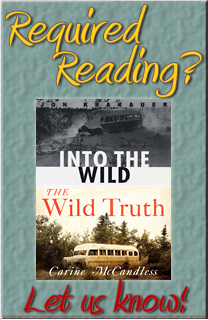Bringing Truth to the Wild, November 18, 2014 – Dr. Douglas Kennedy, Ed.D., CPRP, Virginia Wesleyan College
This week’s press is filled with new information about an old story: that of Chris McCandless, the subject of Jon Krakauer’s 1996 bestselling book, Into the Wild. As millions of people now know, Chris was a young man whose cross-country adventure ended tragically in the Alaskan wild. In the years that have followed, some have called Chris an inspiration while others have called him a fool. And a generation of high school and college students has benefited from required reading that has tested their beliefs about balancing responsibility and pursuing their dreams.
In the eighteen years that Into the Wild has been required reading, it’s allowed millennials who have grown up with answers just a touch of their cell phone away to contemplate a life not easily understood. Schools requiring Into the Wild either as the “summer read” prior to arrival on campus—shortly thereafter as part of a “First Year Experience” program—or as integrated coursework, have found it to provoke exactly what they want within their classrooms: passionate and opinionated discussions offered by students who identify with Chris because of their similarity in age and background. What at first appears to be two camps—”He followed his own path” or “He was selfish and unprepared”—always after time and contemplation blend together. Students start to see that the world isn’t as black and white as their rubric-rich education has trained them. They also learn that there are still questions left unanswered.
Lesson number one: A lot of answers to the world’s problems have been found by those who came before you. Now you’re in college, or soon will be, and it’s your job to come up with your own. Krakauer himself demonstrates how unanswered questions can gnaw at the inquisitive mind; after almost twenty years of swirling theories and criticism over his hypothesis that ingested seeds were the cause of McCandless’s death, he took it upon himself to have a sample of seeds tested. In a New Yorker piece Krakauer wrote long after he could have forgotten about McCandless, he presented the findings that the seeds carried a toxin causing paralysis. This supported not only his own theory, but that of McCandless, who had written in his journal, “fault of potato seed.”
Cause of death answered? Hardly. The debate continues and provides students with lesson number two: Don’t be so fast to accept the “truth.” At a time when most students consider “digging” for information going to a third screen in a google search, Krakauer proves otherwise in his continued quest to understand this story.
Now students can learn a third lesson: Things change, and sometimes your opinion should, too. After years of reading and hearing the opinions of others, Christopher McCandless’s sister Carine has spoken about her own life and added information needed to truly understand her brother. Her book, The Wild Truth, opens the front door to the McCandless household, where she and Chris weathered a violent and tumultuous environment. The revelatory book provides new information about her father’s deceptive behavior, her six other brothers and sisters from a different mother, and that she and Chris were in fact the products of an affair. All of a sudden, the selfish brother who was just pursuing his own dreams is seen a great deal more sympathetically. All of a sudden, the self-centered young man who seemed to forget the sister he adored may be viewed as so protective of her that he never shared where he was lest their parents punish her for that knowledge.
What we see in Carine McCandless’s book is what Krakauer knew but was asked by her not to reveal. That too is something many students will identify with, even in an age where every event is self-promoted on social media: people and their families still have secrets. But this new book doesn’t close the story of Chris McCandless’s life, or answer all of our questions. Instead, it allows us to consider new information and possibly change our opinion while learning more about his sister and the lessons she learned from Chris even after his death. The Wild Truth then becomes a companion to Into the Wild, and not a sequel.
That’s lesson four: college courses, and especially those in your major, do not stand alone—they’re integrated. The intro class of course leads into the intermediate class, but so too does the art course develop the creativity needed to succeed in a marketing course. The Wild Truth may stand on its own in the same way that Into the Wild does. But those who read the latter get the most benefit by also reading the former. Perhaps that’s lesson five and the best lesson that Carine McCandless’s book teaches. Students, your learning won’t end when you graduate. Your education helps prepare you for the rest of your life only if your openness to learning continues. For those who longed for more, The Wild Truth provides that opportunity to understand Chris McCandless, his sister, Carine, and how their life growing up shaped them into people who both have a story worth understanding better.




